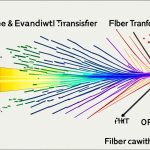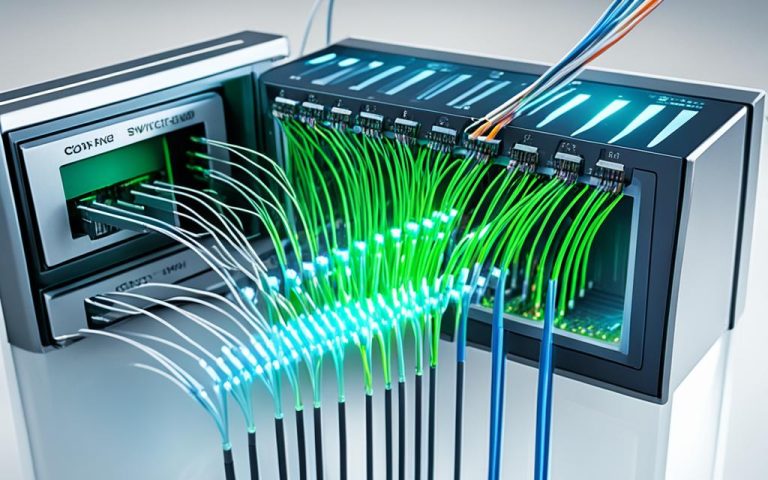Welcome to our comprehensive guide on exploring FTTx architectures. In this article, we will delve into the world of fiber to the home (FTTH) and fiber to the building (FTTB), as well as other variations within the FTTx classification. These architectures are revolutionizing broadband connectivity solutions, providing high-speed internet access and reliable connections for homes and businesses.
Fiber to the home (FTTH) is the most well-known and widely used FTTx architecture. It involves the use of fiber optic cable to directly connect customer homes or premises. With an end-to-end fiber optic connection, FTTH eliminates the need for copper wireline infrastructure, providing faster and more efficient broadband connectivity.
In contrast, fiber to the building (FTTB) brings fiber optic cabling to the electrical room of apartment buildings or businesses. From there, non-optical means such as twisted pair, coaxial cable, wireless, or power line communication are used to transmit the signal within the building. FTTB offers dedicated access to high-speed internet, ensuring 24-hour connectivity for residents and businesses.
Throughout this article, we will also explore other FTTx architectures, including fiber to the node (FTTN) and fiber to the curb (FTTC). Each architecture has its own unique applications and benefits in broadband connectivity solutions.
By understanding the different FTTx architectures, we can appreciate the advantages they bring to the table. These include high-speed internet access, scalability, cost efficiency, and reliability. The use of fiber optic cables ensures a more robust and interference-free connection, meeting the growing demands of consumers and businesses for faster and more reliable broadband connectivity.
Join us as we explore the world of FTTx architectures, uncovering the solutions that are transforming the way we connect and communicate.
Fiber to the Home (FTTH)
FTTH, also known as Fiber to the Home, is a cutting-edge broadband internet connection technology that revolutionizes the way we access and experience the internet. With FTTH, fiber optic cable is directly connected to customer homes or premises, providing an end-to-end fiber optic connection. This advanced technology eliminates the need for outdated copper wireline infrastructure, offering numerous benefits to users.
One of the key advantages of FTTH is its ability to deliver lightning-fast download and upload speeds. With high transmission rates, users can enjoy seamless streaming of videos, online gaming, and real-time video conferencing without any lag or buffering issues. FTTH’s high-bandwidth capacity allows for the transmission of voice, video, and data traffic, delivering an unparalleled internet experience.
The architectural components of FTTH include the Optical Line Terminal (OLT), Optical Distribution Network (ODN), and Optical Network Terminal (ONT). These components work together to facilitate the seamless delivery of broadband internet and other services such as IPTV.
FTTH offers remarkable scalability, making it suitable for various applications and future-proofing network infrastructure. This scalability enables service providers to accommodate an increasing number of users and easily upgrade the network to meet evolving technology demands. Whether it’s for residential or business use, FTTH ensures a reliable and high-speed internet connection.
“FTTH provides an end-to-end fiber optic connection, eliminating the use of copper wireline infrastructure.”
In addition to its superior performance, FTTH offers enhanced security and durability. Unlike traditional copper wires, fiber optic cables are less susceptible to interference and signal degradation, providing a stable and reliable internet connection. FTTH is also immune to electromagnetic interference, weather conditions, and electrical interference.
Furthermore, FTTH is a cost-effective solution in the long run. While the initial installation costs may be higher compared to other access technologies, the maintenance and operational expenses are significantly lower. With fewer components to maintain and replace due to the passive nature of fiber optic networks, FTTH reduces overall operational costs and ensures a higher return on investment.
Switching to FTTH not only improves the internet experience for users but also enhances the overall digital infrastructure of communities. It enables the deployment of advanced services such as smart homes, telemedicine, e-learning, and cloud computing, contributing to economic growth and enhanced quality of life.
Advantages of FTTH:
- Lightning-fast download and upload speeds
- High-bandwidth capacity for voice, video, and data traffic
- Scalability to accommodate future technology demands
- Enhanced security and durability
- Immunity to interference and signal degradation
- Cost-efficiency in the long run
- Enables deployment of advanced digital services
| Technology | Download Speed | Upload Speed |
|---|---|---|
| FTTH | Up to 1 Gbps | Up to 1 Gbps |
| Cable Internet | Up to 300 Mbps | Up to 30 Mbps |
| DSL | Up to 100 Mbps | Up to 10 Mbps |
Table: A comparison of download and upload speeds between FTTH, cable internet, and DSL.
Fiber to the Building (FTTB)
FTTB is a fiber optic access architecture that brings fiber optic cabling to the buildings. Unlike Fiber to the Home (FTTH), which reaches individual units, FTTB terminates at the electrical room of an apartment building or business. From there, the signal is conveyed to its final destination using non-optical means, such as twisted pair, coaxial cable, wireless, or power line communication.
FTTB provides dedicated access for high-speed internet, enabling customers to enjoy 24-hour connectivity by installing a network card on their computers. By leveraging fiber optic cabling, FTTB offers improved transmission speeds and reliability compared to traditional copper-based connections. Businesses and residential complexes can take advantage of FTTB to meet their increasing bandwidth demands and enhance their internet experience.
Fiber optic cabling used in FTTB allows for greater data transmission capacity, accommodating the growing need for bandwidth-intensive applications such as video streaming, online gaming, and cloud-based services. Its dedicated access also ensures consistent performance and stability, ensuring uninterrupted internet connectivity even during peak usage periods.
Advantages of FTTB:
- Enhanced Speed: FTTB delivers high-speed internet connectivity, enabling faster downloads, uploads, and data transfer, meeting the demands of bandwidth-intensive applications and services.
- Improved Reliability: Fiber optic cabling is less prone to interference and signal degradation, providing a stable and reliable internet connection for businesses and residents.
- Scalability: FTTB can easily scale to accommodate increasing bandwidth needs, ensuring that users can adapt to future technological advancements and higher data requirements.
- Secure and Dedicated Access: FTTB offers dedicated access, minimizing the chances of network congestion and ensuring consistent, high-quality internet connectivity for users.

| Advantages of FTTB | Disadvantages of FTTB |
|---|---|
| High-speed internet connectivity | Potential limitations in the last distance connectivity when using non-optical means. |
| Increased reliability and stability | Higher upfront costs compared to traditional copper-based connections. |
| Scalability to meet growing bandwidth demands | Requires additional infrastructure for connecting individual units within buildings. |
| Secure and dedicated access | Potential challenges in retrofitting existing buildings with fiber optic cabling. |
Fiber to the Node (FTTN)
In the FTTx landscape, Fiber to the Node (FTTN) is an architecture that connects optical fiber to a cabinet located a few miles away from customer premises. FTTN serves as an interim solution before full deployment of Fiber to the Home (FTTH). This technology involves the use of copper wireline infrastructure to provide services to customers.
From the FTTN cabinet, a Digital Subscriber Line (DSL) is used to deliver advanced triple-play telecommunications services. This includes high-speed internet, voice, and video services. FTTN is a cost-effective approach that leverages existing copper infrastructure while still offering improved broadband connectivity compared to traditional options.
Benefits of Fiber to the Node:
- Cost-effective deployment using the existing cabinet infrastructure
- Improved broadband connectivity compared to traditional copper-based connections
- Enables the delivery of advanced triple-play services
- Provides a convenient transitional solution before full FTTH deployment
While FTTN offers advantages in terms of cost and improved connectivity, it is important to note that the reliance on copper wireline infrastructure may limit the overall speed and bandwidth compared to full FTTH solutions. Nonetheless, FTTN plays a vital role in delivering reliable and advanced telecommunications services.
| FTTN Architecture | Advantages |
|---|---|
| Optical fiber terminates in a cabinet | Cost-effective deployment using existing infrastructure |
| DSL used to provide services over copper wireline | Improved connectivity compared to traditional copper-based options |
| Enables advanced triple-play services | Convenient transition before full FTTH deployment |
In the next section, we will explore another FTTx architecture known as Fiber to the Curb (FTTC) and its applications in broadband connectivity solutions.

Fiber to the Curb (FTTC)
FTTC, also known as Fiber to the Curb, is an FTTx architecture that brings high-speed fiber optic connectivity closer to the customer premises. In this architecture, the optical cabling terminates within 300 yards of the customer’s location, typically at a curb or junction box near the roadside.
Optical fibers are either installed or utilized along the roadside, extending from the central office to the customer’s home or office. This enables the delivery of faster and more reliable internet connections compared to traditional copper-based alternatives.
The last connection between the curb and the customer’s premises is made using coaxial cable, which efficiently transmits data, voice, and video signals over short distances.
FTTC is an ideal solution for areas where deploying fiber optic cabling directly to each individual premises may not be feasible due to cost or logistical constraints. By terminating the optical cabling closer to the customer, FTTC provides a compromise that offers significant improvements in internet speeds and reliability.
FTTC replaces older telephone services and enables the provision of various communication services through a single line, making it a versatile and cost-effective solution. It combines the speed and capacity of optical cabling with the convenience and familiarity of coaxial cable, ensuring a seamless transition to high-speed internet connectivity.
| Advantages of FTTC: |
|---|
| 1. High-speed internet connectivity |
| 2. Improved reliability and signal quality |
| 3. Cost-effective deployment |
| 4. Seamless integration with existing coaxial cable infrastructure |
| 5. Versatile communication services over a single line |
Image: Optical Cabling in FTTC architecture
Advantages of FTTx Architectures
FTTx architectures offer numerous advantages over traditional copper-based connections. These advantages prove essential in meeting the increasing demands for high-speed internet access, scalability, cost efficiency, and reliability.
High-Speed Internet Access
FTTx architectures, such as FTTH, enable the delivery of high-speed internet connections directly to homes or buildings. With fiber optic technology, users can enjoy faster download and upload speeds, ensuring seamless streaming, gaming, and data transfer.
Scalability
FTTx architectures provide the scalability needed to accommodate growing numbers of users and increasing data demands. These architectures can easily be expanded and upgraded with additional fiber optic cables, allowing service providers to meet the evolving needs of their customers.
Cost Efficiency
FTTx architectures offer cost efficiency through the use of passive components. Fiber optic cables require less maintenance and troubleshooting compared to traditional copper-based connections, reducing operational costs for service providers and minimizing service disruptions for end-users.
Reliability
Fiber optic cables used in FTTx architectures are highly reliable, as they are less susceptible to interference and signal degradation. This ensures a consistent and stable internet connection, even during peak usage periods.
“The Advantages of FTTx architectures, such as high-speed internet access, scalability, cost efficiency, and reliability, make them the preferred choice for delivering broadband connectivity solutions.”
| Advantages | High-Speed Internet Access | Scalability | Cost Efficiency | Reliability |
|---|---|---|---|---|
| Benefits | Fast download and upload speeds for seamless streaming and data transfer | Ability to accommodate growing numbers of users and increasing data demands | Reduced operational costs and minimized service disruptions | Consistent and stable internet connection, even during peak usage |
As technology advances and the need for high-speed internet access continues to grow, FTTx architectures remain at the forefront of delivering reliable, scalable, and cost-effective broadband connectivity solutions.
Conclusion
FTTx architectures, in combination with GPON technology, have revolutionized broadband connectivity, offering users high-speed, reliable, and scalable solutions. By optimizing the use of optical fiber, FTTx architectures empower service providers to deliver a wide range of broadband services while reducing costs.
As the demand for high-speed internet continues to grow, FTTx architectures will play a crucial role in meeting the needs of both consumers and businesses. The implementation of FTTx technology ensures faster and more reliable broadband connectivity, allowing users to effortlessly stream high-definition videos, engage in online gaming, and work remotely with ease.
With its ability to support increased bandwidth and accommodate future technological advancements, FTTx architectures pave the way for the digital transformation of societies. By leveraging GPON technology and FTTx architectures, service providers can bridge the digital divide and provide seamless connectivity to both urban and rural areas, enabling a more inclusive and equitable society.
FAQ
What is FTTH?
FTTH stands for Fiber to the Home, which is a broadband internet connection technology that uses fiber optic cable to directly connect to customer homes or premises. It provides an end-to-end fiber optic connection, eliminating the use of copper wireline infrastructure.
What is FTTB?
FTTB stands for Fiber to the Building, which is a fiber optic access architecture where the optical cabling terminates at the buildings. Unlike FTTH, which reaches individual units, FTTB only reaches the electrical room of an apartment building or business.
What is FTTN?
FTTN stands for Fiber to the Node, which is an FTTx architecture where the optical fiber terminates in a cabinet located a few miles from the customer premises. From the cabinet, a digital subscriber line (DSL) is used to provide services to customers over copper wireline infrastructure.
What is FTTC?
FTTC stands for Fiber to the Curb, which is an FTTx architecture where the optical cabling terminates within 300 yards of the customer premises. Fiber cables are installed or utilized along the roadside from the central office to the home or office. The last connection between the curb and the customer premises can use coaxial cable.
What are the advantages of FTTx architectures?
FTTx architectures offer several advantages over traditional copper-based connections. These include high-speed internet access, scalability to accommodate more users, cost efficiency due to the use of passive components, and reliability as fiber optic cables are less susceptible to interference or signal degradation.




















4 Comments